The Representativeness of Olea Pollen from Olive Groves and the Late Holocene Landscape Reconstruction in Central Mediterranean
- 1Laboratorio di Palinologia e Paleobotanica, Dipartimento di Scienze della Vita, Università di Modena e Reggio Emilia, Modena, Italy
- 2Plant Physiology Lab, Dipartimento di Scienze della Vita, Università di Modena e Reggio Emilia, Reggio Emilia, Italy
Modern pollen spectra are an invaluable reference tool for paleoenvironmental and cultural landscape reconstructions, but the importance of knowing the pollen rain released from orchards remains underexplored. In particular, the role of cultivated trees is in past and current agrarian landscapes has not been fully investigated. Here, we present a pollen analysis of 70 surface soil samples taken from 12 olive groves in Basilicata and Tuscany, two regions of Italy that exemplify this cultivation in the Mediterranean basin. This study was carried out to assess the representativeness of Olea pollen in modern cultivations. Although many variables can influence the amount of pollen observed in soils, it was clear that most of the pollen was deposited below the trees in the olive groves. A rapid decline in the olive pollen percentages (c. 85% on average) was found when comparing samples taken from IN vs. OUT of each grove. The mean percentages of Olea pollen obtained from the archeological sites close to the studied orchards suggest that olive groves were established far from the Roman farmhouses of Tuscany. Further south, in the core of the Mediterranean basin, the cultivation of Olea trees was likely situated ~500–1,000 m from the rural sites in Basilicata, and dated from the Hellenistic to the Medieval period.
Introduction
The olive tree is an important marker of the Mediterranean cultural landscapes. Molecular, archaeobotanical, and paleoenvironmental data are acknowledged as essential for reconstructing the history of the domesticated olive tree (Zohary and Hopf, 2000; Newton et al., 2014). Together with the walnut and chestnut trees, the present geographical distribution of genetic diversity in Olea europaea L. was perhaps more influenced by human activities than by its natural migration and colonization (Bottema and Woldring, 1990; Baldoni et al., 2006), a view confirmed by the frequent recovery of this pollen in the deposits from archeological sites (Mercuri et al., 2013). Accordingly, Olea pollen may be regarded as an indicator of human presence and activity in a certain area. However, the species includes both wild and domesticated subspecies (O. europaea L. ssp. sylvestris and O. europaea L. ssp. europaea, respectively) that have quite similar pollen morphology (Roselli, 1979; Ribeiro et al., 2012; Messora et al., 2017). Another problem arises from the fact that O. europaea is an evergreen xerophilous tree, whose growth is promoted by a warming climate (Moriondo et al., 2013). Recent studies have demonstrated that a seasonal analysis is required to establish robust relationships between the Mediterranean climate and olive development (Aguilera et al., 2015); therefore, an increasing trend in the pollen curves may have ambiguous significance in the diagrams from the Mediterranean Holocene records. Palynologists have concluded that Olea pollen may be considered both a proxy of warming and drought conditions, as well as the product of a fruit-bearing plant dispersed and cultivated by humans. High percentages of this pollen recovered in the spectra from archeological sites, or from human-influenced off-sites, can reasonably result from a process of cultivation. However, it is not clear how much “high” may be the percentage of Olea pollen in modern agrarian landscapes. Today, Olea pollen is common and among the most abundant airborne pollen in the Mediterranean countries (e.g., Galán et al., 2004; Ziello et al., 2012; Mercuri, 2015). In aerobiology, volumetric spore traps were placed in olive groves to study the phenology and the delayed pollination season of olive groves located at higher altitudes (in SE Spain: Aguilera and Valenzuela, 2012). Nevertheless, the amount of pollen that fell to the ground and was trapped in sediments below olive trees and near modern groves has not yet been systematically assessed.
In this paper, we discuss the representativeness of Olea pollen in surface soil samples taken from modern Italian olive groves, with the aim of contributing to the interpretation of past pollen spectra. To our best knowledge, this is the first study of surface soil sediments from this widespread type of crop cultivation. This is somewhat surprising, considering that knowledge of current pollen rain may be the best reference tool for understanding and reconstructing the environments and agrosystems of the past (e.g., Cañellas-Boltà et al., 2009; Fall, 2012; Davis et al., 2013). Since most pollen-based landscape reconstructions are based on sophisticated quantitative pollen analyses and modeling estimates, this paper instead proposes a basic observational test to provide much-needed reference data for the complex and fragmented Mediterranean landscapes during the late Holocene. This simpler approach can improve our understanding of the historical development of Mediterranean cultural landscapes. The same methodology, but applied in a different approach, was used by Vermoere et al. (2003) to compare the modern and subfossil pollen assemblages through “modern analogs” and multivariate statistics in their study of an “olive landscape” in SW Turkey (Sagalassos).
Today, most of the total area with olive groves is estimated to lie in the Mediterranean basin, with the highest olive production quantities occurring in Spain and Italy (FAOSTAT, 2017; Figure 1). The focus of our palynological research is centered on the olive plantations located in Italy, a country extraordinarily rich of agroforestry traditions and olive cultivars of the central Mediterranean basin (Rühl et al., 2011). Such cultivation is widespread in the central-southern regions and the islands where the local environmental conditions are most favorable to olive growth. For our study, we selected Tuscany and Basilicata, two of the most productive agrarian regions in Italy, with large olive groves in their territories (Pisante et al., 2009; Figure 2). These regions couple modern plantations, characterized by different cultivars, with an impressive record of archeological sites preserving evidence of long-term agricultural activity carried out for millennia (Florenzano, 2013; Vaccaro et al., 2013; Bowes et al., 2015). Therefore, we have the opportunity to directly compare past (archeological) and present (olive grove) pollen spectra from the same areas. The results should be useful for assessing the significance of this pollen and tree in the late Holocene history of these two regions, which can serve as an exemplar for the entire peninsula.
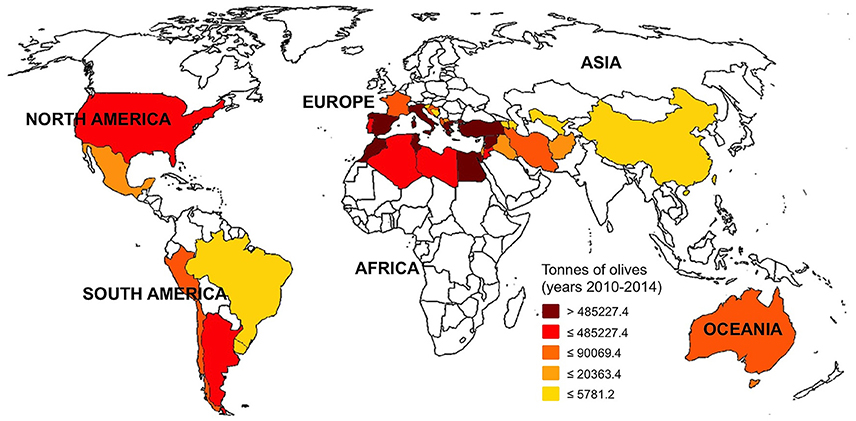
Figure 1. Distribution map showing the production quantities by country, estimated in tons of olives (in the legend) redrawn from FAOSTAT database for 2017.
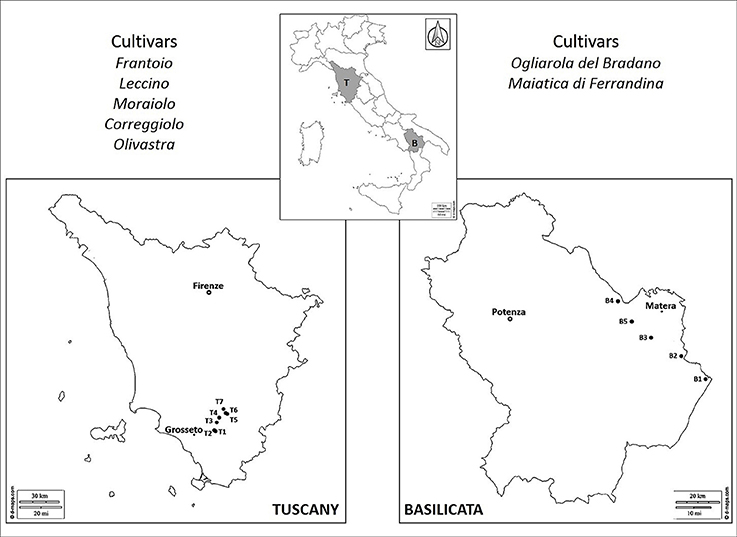
Figure 2. Map of Italy showing the locations of the 12 olive groves studied in Basilicata (B, Southern Italy) and Tuscany (T, Central Italy). The cultivars of Olea europaea L. ssp. europaea cultivated in these olive groves are reported at the right (B) and left (T) of the map. The labels of the olive groves (B1–5, and T1–7) follows the list embedded in the Figure 2 graphic.
Materials and Methods
Pollen Sampling and Study Areas
Surface soils were collected from 12 olive groves: five were located in Basilicata (B1–5, cultivated along the Bradano River, in the province of Matera) and seven in Tuscany (T1–7, grown in the commune of Cinigiano, in the province of Grosseto; Figure 2). These two regions have quite heterogeneous soil structures, ranging from alluvial soils along the rivers to marine-origin sandy-gravel deposits in the hinterlands (Pieri et al., 1996; Costantini and Righini, 2002).
The climate of the two regions has a typical Mediterranean seasonality, with rainy winters and dry summers, but with regional differences depending on the latitude and elevation. In Basilicata, the climate is influenced by both the hydrographic basin of the Bradano River and the Ionian Sea, while in Tuscany it is by the warm current from the Tyrrhenian Sea (mean annual temperatures from both regions: from 13 to 16°C; mean annual rainfall: from 300 to 700 mm. Data from regional meteorological archives of Archivio Meteo Storico).
Mediterranean vegetation characterizes the two regions, although mesophilous plant associations are also distributed in the studied areas. In Basilicata, broadleaved deciduous forests are the dominant vegetation communities of the inner lands, whereas Pinus halepensis Mill. forest are spread along the coast (Blasi, 2010). A widespread occurrence of woodlands composed of evergreen sclerophylls and broadleaf deciduous trees and shrubs characterize the southern Tuscany vegetation (Selvi, 2010). Some pine tree stands (Pinus nigra J. F. Arnold, P. pinaster Aiton, P. pinea L., and P. halepensis) now cover this territory after being reforested over the last two centuries (Ciabatti et al., 2009). The olive groves include different cultivars, commonly organized in mixed plantations of variable size and expansion (Figure 3). In this study, each olive grove was selected to be the farthest away possible from other groves in the same area (Florenzano et al., 2011). However, in Basilicata and Tuscany olive groves account approximately for c. 11% of the Italian territory planted with olive trees, and the density of these tree cultivations is so high that they often color and characterize the landscape of these two regions (from ISTAT—National Institute of Statistics 2011: Basilicata: 31.350 ha, and Toscana: 97.241 ha of olive orchards).
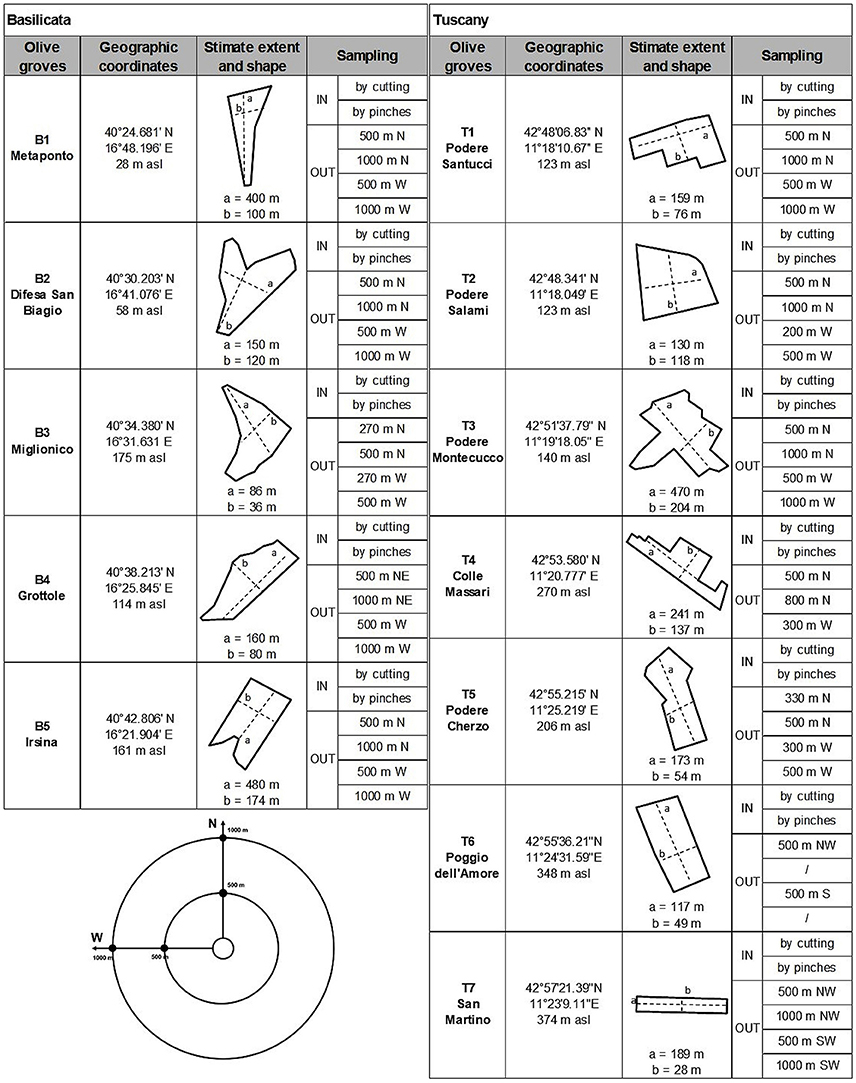
Figure 3. Surface pollen samples taken from the olive groves located in Basilicata (B) and Tuscany (T), Italy; the geographical coordinates, size of the plantation, and type of sampling are shown. a, maximum length; b, maximum width; IN, samples taken from the center of the olive groves; OUT, peripheral samples. The olive grove extent is that for the sampling year (2010 for Basilicata, 2011–13 for Tuscany). Bottom left: the model of pollen sampling in the olive groves.
Two samples were taken from the center of each plantation (IN), and four samples from the peripheral positions (OUT), at a distance of c. 250–500 and 1,000 m depending on geomorphologic and anthropogenic limits, but always along the SE and the NW transects.
A total of 70 samples were collected from bare ground—not covered by grass—“by cutting” out an c. 2-cm thick portion of the surface soils. One of the IN samples was picked up according to the method of sampling “by pinches” (e.g., used in forensic palynology; Horrocks et al., 1998; Bryant and Jones, 2006): soil sub-samples were taken from several points over a c. 1 m2 area, mixed, and put into a single small plastic bag per sample. Since the pollination of different cultivated crops occurs at different periods, normally between April and June in the western and central Mediterranean (Fornaciari et al., 2000; Osborne et al., 2000), the samples were collected in the spring or summer seasons, i.e., immediately before (early April) or after (July) the blooming periods of the olive trees.
Reference Data from Archeological Literature
Data from the archeological layers were obtained from the pollen analyses of 12 sites located in Basilicata (BI–VII) and in Tuscany (TI–V)—as part of multidisciplinary research carried out by independent projects (for list and references see Table 1)—and selected to compare the presence of Olea in modern and past pollen spectra. The archeological sites were mainly rural settlements and farmhouses belonging to different cultural periods, from Hellenistic to Medieval in Basilicata, and from the Augustean Roman age in Tuscany. The chronology of the sites was mainly determined by their archeological materials (e.g., pottery), and to a lesser extent by radiocarbon dates and layer correlations. Based on both the pollen data and archeological evidences, environmental reconstructions emphasize the importance of oliviculture in the past economies of these lands (Florenzano, 2013; Bowes et al., 2017). In Basilicata, the Greek and Roman settlements were characterized by well-developed economic activities, including agricultural and pastoral practices (Florenzano and Mercuri, 2012). An organized road network and an efficient irrigation and drainage system characterized this land (Carter and Prieto, 2011). After a period of crisis linked to the fall of the Roman Empire (ca. 4–11th century AD), agricultural practices resumed during the Medieval period, and included olive cultivations within the monastic communities (Sogliani and Marchetta, 2010). In Tuscany, the archaeobotanical and archeological data point to a phase of intensive land use in the late Republican/early Imperial date (ca. 1st century BC/1st century AD). Along with the significant presence of cereals, the grape vines, and olives attest to the importance of Mediterranean crops in rural contexts, which were small and mainly occupied on a temporary/short-period basis (Rattighieri et al., 2013; Bowes et al., 2015).
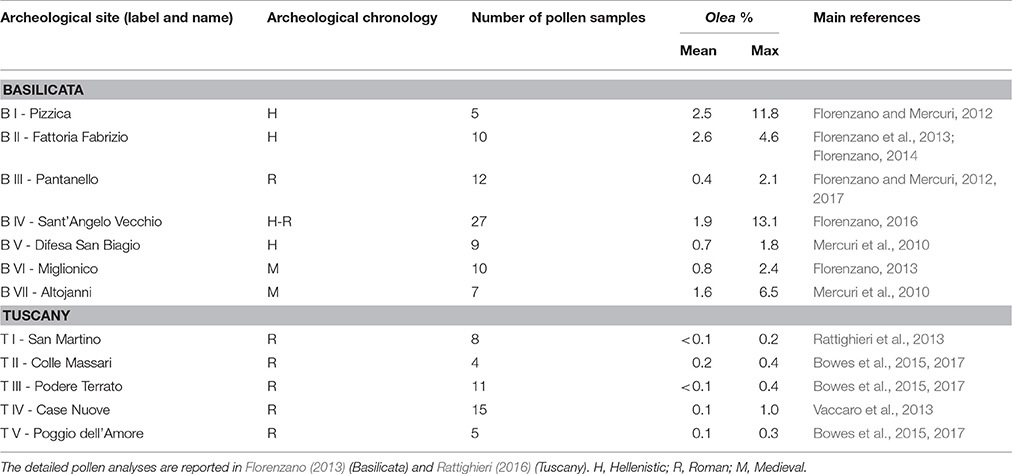
Table 1. Percentage of Olea pollen from the archeological sites close to the modern olive groves studied in this paper, and relevant references.
Pollen Analysis
An amount of 2–5 g of wet weight per sample of surface soil sediment was treated for pollen extraction (Florenzano et al., 2012). Lycopodium spores were added for the calculation of pollen concentration (expressed in pollen grains per gram = p/g). The method involves deflocculation with Na-pyrophosphate 10%, sieving with nylon filter of 7 μm mesh, carbonate dissolution with HCl 10%, acetolysis (Erdtman, 1960) to remove part of the organic substance, enrichment with heavy liquid (Na-metatungstate hydrate) to concentrate the pollen with flotation, dissolution of silicates with HF 40%. The residues were mounted in slides, fixed in glycerol jelly and sealed with paraffin. Pollen counts (up to about 500 pollen grains per sample) were carried out under 400x with a light microscope. For the purpose of this research, we counted only Olea, Pinus, and the number of total pollen grains in the Pollen Sum. Olea was identified as trizonocolpate-colporate pollen with reticulate exine, and a polar axis of ~20 μm. Pinus is a high pollen producing tree, and has a saccatae pollen with a maximum diameter of c. 70 μm in many species (e.g., P. nigra—Accorsi et al., 1983; Pinus pinea—Accorsi et al., 1978; Desprat et al., 2015). As Pinus was an important component of some pollen spectra, obtaining the pine values helped us assess the underestimation of Olea pollen in several olive groves.
Pollen values reported in the Results section below are the mean pollen concentrations or percentages calculated from the average data of the two (IN) or four (OUT) pollen samples per olive grove.
Pollen Data Elaboration
Data were imported into Microsoft Excel 2013 and used to make the graphs. Data elaborations show the trends of olive pollen deposition at three distances from their source (IN, 500 and 1,000 m). Their linear trends were based on the coefficient of determination (R2) by using linear analysis tools. Principal component analysis (PCA) was performed, by using the XLSTAT 2014 software, to display the distribution of the samples (variables) with respect to Olea, Pinus, and the total pollen from other taxa observed in the samples.
Results
The pollen analysis from surface soils (Table 2) shows that the total pollen concentrations are always significant, ranging from min. c. 20,000 p/g (B5, higher IN than OUT) to max. c. 130,000 p/g (T2, higher OUT than IN). One half of the samples IN contains higher total concentrations than OUT. The total pollen concentrations are higher in Tuscany than in Basilicata (73,138 vs. 40,137 p/g on average), possibly reflecting the different soil composition and richness of organic matter.
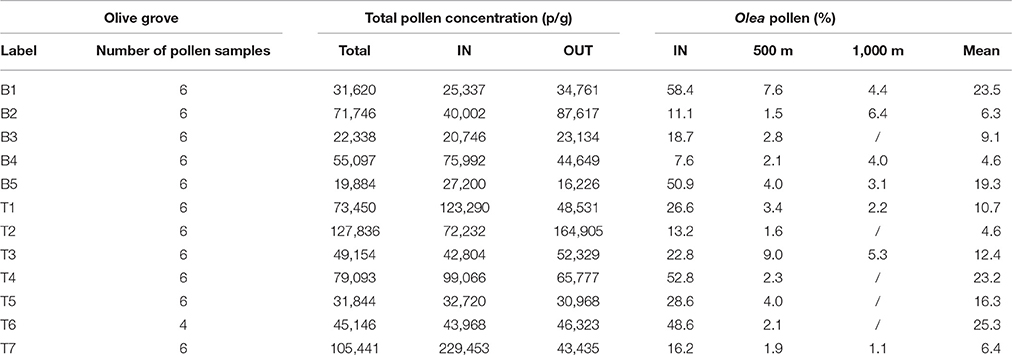
Table 2. Results of the pollen analyses: concentration (p/g = pollen per gram) of all the pollen grains found in the soil surface samples, and the percentages of Olea pollen counted in the IN and OUT samples of each plantation.
The mean percentage of Olea pollen in the samples was similar between the two regions (T = 29.8% vs. B = 29.3%). The IN samples had significant percentages of Olea, from 8% in B4 to 58% in B1, but only three olive groves showed Olea at >50% for the IN spectra (B1, B5, and T4). In five IN samples, Olea occurred at <20% (B2, B3, B4; T2, T7); these values, however, reached to 30–40% when Pinus was excluded from the counts. The highest Olea percentages came from the sites B1 (IN: c. 58%) and T4 (IN: c. 53%). However, the more extensive olive groves (B5 and T3; Figure 3) had lower values (IN: c. 51% in B5, and c. 23% in T3). This indicated that an evident relationship was lacking between the size and representativeness of Olea pollen taken from the center of an olive grove.
The presence of Olea strongly decreased for OUT, at 500 m (2–9%), whereas Olea values were more variable for OUT at 1,000 m (Table 2; Figure 4). In some cases (B2, B4), an increase in Olea percentage is observed reflecting the pollen rain from other olive trees/groves growing in the area.
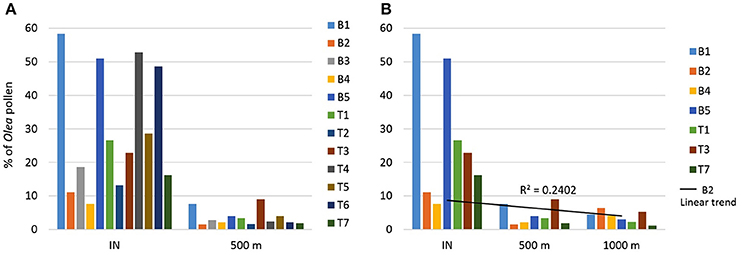
Figure 4. Trends of Olea pollen deposition observed in the olive groves: (A) IN and 500 m (for all 12 sites), and (B) IN, 500 and 1,000 m (for seven sites: the sites without samples at 1,000 m were excluded). R2 = coefficient of determination.
The PCA (Figure 5) allowed for the comparison of pollen spectra and sites, and separated them along the distance and composition features. In the sectors III and II, the IN samples—taken from the center of olive groves—are concentrated with the highest Olea percentages; moreover, samples with a significant presence of Pinus are concentrated in sector II. By contrast, most of the OUT samples taken at 500 m and 1,000 m from the groves center, were plotted in the sectors I and IV; hence this revealed that other taxa influenced these spectra.
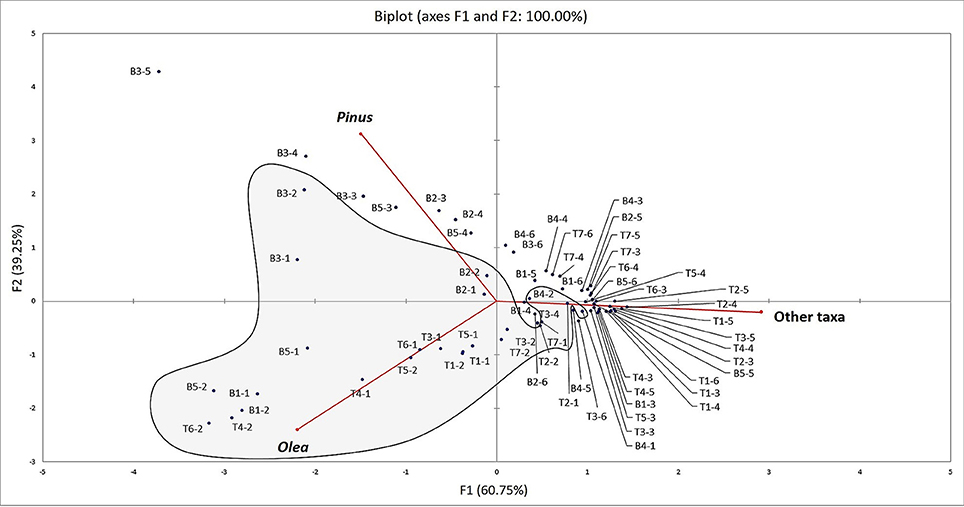
Figure 5. Principal component analysis (PCA; elaboration: XLSTAT 2014) for the 70 samples from the 12 studied olive groves. The modern pollen spectra shows that the percentage of Olea depends on the distance from the olive groves (sector III), and on the presence of Pinus (II) or other taxa (IV, I).
Discussion
The Representativeness of Olea in the Olive Orchards
As expected, Olea pollen was consistently present in the pollen spectra from the olive groves. Generally, we know that pollen released from trees is transported, in part, by wind through the canopy, and partly is trapped by the foliage and eventually falls by gravity in the wood (McKibbin, 2006). The local signal and the anemophilous pollination are predictive of a good amount of Olea pollen grains in and around the groves. Although this pollen is one of the main components in the airborne pollen rain of Mediterranean countries, the yearly percentage of Olea pollen is not usually reported, and so direct comparison between such aerobiological data and soil pollen spectra is not possible (Ziello et al., 2012). Data from airborne pollen monitoring by the station of Matera (years 2005–2006, by ARPAB) suggested that Olea pollen is generally less represented in the air than in the surface soil layers (Florenzano et al., 2011), a pattern also evident for Prunus orchards (Mercuri, 2015). The pollen of Olea was c. 7–11% of the yearly pollen rain, while, in our study, it was 13% on average in the IN and OUT surface soil samples of the B-groves (this value was calculated from the Table 2 data). Nevertheless, we found that Olea pollen had very variable percentages (2–58%) depending on the IN and OUT point locations of sampling. We found that, in general, the highest values of Olea pollen were recorded in those samples taken from the center of the plantation but no relationship between the size of the olive groves and the amount of olive pollen accumulated in these IN samples. We estimated that the highest values observed in the IN samples, from B1 and T4, sharply dropped from c. 58–53 to c. 5% at 500 m. Hence, Olea pollen could be estimated to decrease by 61–96% in the first few hundred meters from its source. Accordingly, Adams-Groom et al. (2017) showed that most pollen from isolated trees [Carpinus betulus L., Cedrus atlantica (Endl.) Manetti ex Carrière, Juglans nigra L., and Platanus acerifolia (Aiton) Willd.] was deposited beneath the canopy (range 63–94%), following an exponentially decreasing curve. An exponential decline was also observed in Vitis pollen as function of its distance away from the vineyard edge: Vitis pollen can be detected within vineyard soils, but rapidly reaches very low concentrations (<0.1%) or disappears altogether in soils outside vineyards (Turner and Brown, 2004). In the surface soil pollen-deposition patterns of hornbeam, cedar, walnut, and plane pollen, the tailing-off began at the outer edge of the canopy; the amount of pollen deposited at 50 m was <2.6% and at 100 m it was <0.2% of total deposition in the samples for any tree (Adams-Groom et al., 2017). Bunting (2002), who studied modern pollen deposition in and around woodlands, by using moss polsters and surface sediments from small lakes, also found that local woody pollen percentages generally reached background levels of <100 m from the woodland edge. The rapid decline of tree pollen grains with distance is reported from additional studies (e.g., Broström et al., 2005), which often remark on the 100-m threshold from the woodland edge for the dramatic decrease of tree pollen (Tinsley and Smith, 1974).
The slope of imaginary lines connecting each percentage value at the IN and 500 m sampling sites was negative for each olive grove we considered. This confirms a substantial decrease of pollen deposition at 500 m (Figure 4A). Farther, however, the percentages remain fairly constant, or even increase in the samples taken at 1,000 m sites, and thus inconsistent with the previous one (Figure 4B). A plausible explanation for this result is that the great density of olive groves in the studied areas (mentioned above) caused an abundant pollen emission of airborne pollen in the relevant sampled areas. Many factors likely contributed to the variability of Olea pollen percentages in our samples. For example, aerobiological data report that olive-growing areas act as good Olea pollen sources but give contribute differently to the airborne pollen rain depending on the prevalent wind direction and the size of groves (Hernandez-Ceballos et al., 2012). Besides the extent of olive groves, the tree size- and age-distributions, the gap between the sampling date and the start of the pollination period (April), the tree density and canopy closure, the abundance of overrepresented pollen from other taxa in the pollen spectra (Pinus), the occurrence of particular agricultural practices (e.g., plowing), and the spread of olive groves or the presence of wild olive specimens in the same area, are all variables capable of influencing our olive grove spectra.
The Pollen Evidence of Past Olive Groves near Archeological Sites
Our results obtained from the modern pollen spectra may help to interpret spectra from archeological sites (Table 3). The mean percentages of olive pollen from the archeological sites located in Basilicata suggest that the olive groves were c. 500 m in distance from BI, BII, BIV, and BVII, yet > 500 m from BIII, BV, and BVI. According to these data, oliviculture was one of the most relevant features of the past landscape and economy of Basilicata (Florenzano, 2013). Although Mediterranean vegetation was prevalent in southern Italy, the influence of wild olive does not seem to have had significant incidence in the past spectra from this region: according to the archeological and historical literature, olive cultivation was spread since the 7–6th century BC and favored by the Greek colonization. From that period onward, this crop has largely influenced the agrarian system of this territory (van der Mersch, 1994; De Siena, 2001).
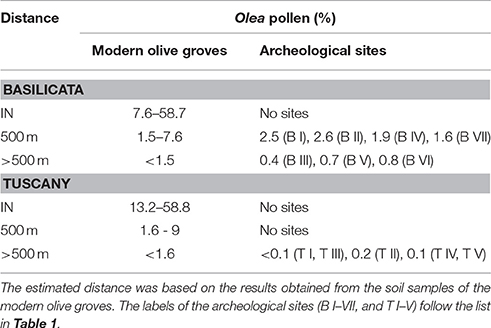
Table 3. Percentage of Olea pollen from the archeological sites of Basilicata and Tuscany, in relation to the distance from the center of an olive grove.
The archeological sites located in Tuscany always had very low Olea pollen values (≤0.2%), suggesting that the olive groves were not distributed within 1,000 m of the Roman farmhouses of the Cinigiano district. This is due, in part, to the fact that the sites were small facilities, mainly used seasonally to process cereals, or for animal husbandry, so that herbaceous crops cultivated for food and fodder especially influenced the pollen spectra. However, the low values of Olea pollen are recurrent in these sites of Tuscany. Although the Roman agriculture was intensive and complex, we can conclude that oliviculture was not a landscape feature of this region at that time.
A net of off-sites helps to reconstruct the history of this plant in the Italian peninsula. In southern Italy, many off-site records contain Olea pollen dating back to the early Holocene (Pergusa lake and Gorgo Basso in Sicily: Sadori and Narcisi, 2001; Tinner et al., 2009; Lago di Trifoglietti in Calabria: Joannin et al., 2012). Afterwards, the fairly continuous curve of Olea begins at c. 6500 cal BP during the mid-Holocene (Lago Salso and Lago Alimini Piccolo in Apulia: Di Rita and Magri, 2009; Di Rita et al., 2011; Lago Battaglia: Caroli and Caldara, 2007). From c. 3,600 cal BP onward, Olea curves increase in Lago Alimini Piccolo and Lago di Pergusa (c. 20% in both sites), but also increasing in Lago Battaglia at c. 3,100 and 2,600 cal BP. Similarly, in central Italy, some off-site cores show the occurrence of Olea during the early Holocene (Lago dell'Accesa in Tuscany: Drescher-Schneider et al., 2007), with its continuous presence from c. 7,300 to 7,000 cal BP also at Lago del Greppo (Vescovi et al., 2010). In Tuscany, at Lago di Massaciuccoli (Mariotti Lippi et al., 2007), Olea pollen is present in traces amounts, and found only in the layers dating to the Roman Age; also elsewhere in the region, Olea was discontinuously recorded in low amount (Mariotti Lippi et al., 2015; Mariotti Lippi in verbis). Then, at c. 2,800–2,700 cal BP, Olea increased together with Juglans and Castanea, and with cereals and other anthropogenic indicators, thus clearly showing the development of cultural/agrarian systems (at Lago di Vico, Lago dell'Accesa and Lago Battaglia: Magri and Sadori, 1999; Caroli and Caldara, 2007; Drescher-Schneider et al., 2007). These data show the general chronological trend of olive pollen from traces to high percentages in the Holocene off-sites (e.g., Lago Alimini Piccolo), but the meaning of Olea presence in the off-site and on-site cores is different (Mercuri et al., 2013). We must remember that these records are from areas that lie within the distribution of wild olive trees. In lake records, where we cannot expect the growth of olive trees at the sampling locations, the presence of pollen from these trees does not strictly mean that they were cultivated. The high amounts of Olea in these records (>2%) may be evidence of (mixed) wild stands that occurred besides the plantations in the area (as regional pollen rain is recorded in off-sites); hence, the significance of this pollen requires careful consideration of the chronology and proximity of archeological sites to the off-site.
Conclusions
Our data show that olive trees can depict a significant picture in pollen spectra, and that their highest percentages are evidence of the local presence of cultivations in a given area. Low percentages of Olea pollen may be interpreted as being the result of long-distance transport, while percentages of >2% may indicate the presence of plantations at least 1,000 m from the sampling point(s).
Olea pollen from modern olive groves provides a reference-tool that is useful for paleoenvironmental reconstructions (as generally attested: Davis et al., 2013), and it is important to know the role of olive cultivation in the development of cultural landscapes. As mentioned above, the significance of olive pollen in past spectra is sometimes controversial, since the presence of wild trees enlarge the signal of the species, and the warming phases have a role in spreading olive trees in the Mediterranean landscapes.
The transformation of natural to human-influenced environments (Zanchetta et al., 2013; Mercuri and Sadori, 2014), from the local to trans-regional spatial scales (Mercuri, 2014), may be tracked by observing the presence and trends of Olea both in and near the archeological sites. Our work suggests the cultivation of olive trees has been a long-time activity along the Bradano River in Basilicata, whereas it is a relatively recent one for the agrarian landscape of the Cinigiano district in Tuscany. The research reported in this paper, carried out in two regions with a strong agriculture vocation, shows that the long tradition in olive cultivation marks the present and past pollen spectra, and that it clearly remains evident in the current Mediterranean landscapes.
Author Contributions
AM and AF planned the research, and wrote the paper with the cooperation of RF; RR, ER, and AF made pollen sampling and analyses; RF made statistic and graphical elaborations; RM and LA studied olive grove distribution and pollen morphology. All authors read and approved the final manuscript.
Funding
This work was supported by the national-funded project SUCCESSO-TERRA (Human societies, climate, environment changes and resource exploitation/sustainability in the Po Plain at the Mid-Holocene times: the Terramara; Ministero del'Istruzione, dell'Università e della Ricerca PRIN-20158KBLNB).
Conflict of Interest Statement
The authors declare that the research was conducted in the absence of any commercial or financial relationships that could be construed as a potential conflict of interest.
Acknowledgments
Archaeological sites are listed in the BRAIN database (http://brainplants.unimore.it/). Meteorological data are available from Archivio Meteo Storico (https://www.ilmeteo.it/portale/archivio-meteo/Montescaglioso?refresh_cens; https://www.ilmeteo.it/portale/medie-climatiche/Cinigiano?refresh_ce).
References
Accorsi, C. A. A., Aiello, M., Bandini Mazzanti, M., Bertolani Marchetti, D., De Leonardis, W., Forlani, L., et al. (1983). Flora Palinologica Italiana: Schede Elaborate Tramite Computer. Forlì: Publisher Valbonesi.
Accorsi, C. A. A., Bandini Mazzanti, M., and Forlani, L. (1978). Modello di schede palinologiche di Pini Italiani: Pinus cembra L., Pinus pinea L., Pinus silvestris L. subsp. silvestris (ecotipo emiliano). Forlì: Publisher Valbonesi.
Adams-Groom, B., Skjøth, C. A., Baker, M., and Welch, T. E. (2017). Modelled and observed surface soil pollen deposition distance curves for isolated trees of Carpinus betulus, Cedrus atlantica, Juglans nigra and Platanus acerifolia. Aerobiologia. 33, 407–416. doi: 10.1007/s10453-017-9479-1
Aguilera, F., and Valenzuela, L. R. (2012). Altitudinal fluctuations in the olive pollen emission: an approximation from the olive groves of the south-east Iberian Peninsula. Aerobiologia 28, 403–411. doi: 10.1007/s10453-011-9244-9
Aguilera, F., Fornaciari, M., Ruiz-Valenzuela, L., Galán, C., Msallem, M., Dhiab, A., et al. (2015). Phenological models to predict the main flowering phases of olive (Olea europaea L.) along a latitudinal and longitudinal gradient across the Mediterranean region. Int. J. Biometeorol. 59, 629–641. doi: 10.1007/s00484-014-0876-7
Baldoni, L., Tosti, N., Ricciolini, C., Belaj, A., Arcioni, S., Pannelli, G., et al. (2006). Genetic structure of wild and cultivated olives in the Central Mediterranean Basin. Ann. Bot. 98, 935–942. doi: 10.1093/aob/mcl178
Bottema, S., and Woldring, H. (1990). “Anthropogenic indicators in the pollen record of the Eastern Mediterranean,” in Handbook of Man's Role in the Shaping of the Eastern Mediterranean Landscape, eds S. Bottema, G. Entjes-Nieborg, and W. van Zeist (Rotterdam: Balkema), 231–264.
Bowes, K., Mercuri, A. M., and Rattighieri, E. (2015). Palaeoenvironment and land-use of Roman peasant farmhouses in southern Tuscany. Plant Biosyst. 149, 174–184. doi: 10.1080/11263504.2014.992997
Bowes, K., Mercuri, A. M., Rattighieri, E., Rinaldi, R., Arnoldus-Huyzendveld, A., Ghisleni, M., et al. (2017). “Peasant agricultural strategies in Southern Tuscany: convertible agriculture and the importance of pasture,” in Rural Communities in a Globalizing Economy, eds. T. de Haas and G. W. Tol (Leiden: Brill), 170–199.
Broström, A., Sugita, S., Gaillard, M. J., and Pilesjö, P. (2005). Estimating the spatial scale of pollen dispersal in the cultural landscape of southern Sweden. Holocene 15, 252–262. doi: 10.1191/0959683605hl790rp
Bryant, V. M., and Jones, G. D. (2006). Forensic palynology: current status of a rarely used technique in the United States of America. Forens. Sci. Int. 163, 183–197. doi: 10.1016/j.forsciint.2005.11.021
Bunting, M. J. (2002). Detecting woodland remnants in cultural landscapes: modern pollen deposition around small woodlands in northwest Scotland. Holocene 12, 291–301. doi: 10.1191/0959683602hl545rp
Cañellas-Boltà, N., Rull, V., Vigo, J., and Mercadé, A. (2009). Modern pollen—vegetation relationships along an altitudinal transect in the central Pyrenees (southwestern Europe). Holocene 19, 1185–1200. doi: 10.1177/0959683609345082
Caroli, I., and Caldara, M. (2007). Vegetation history of Lago Battaglia (eastern Gargano coast, Apulia, Italy) during the middle-late Holocene. Veg. Hist. Archaeobot. 16, 317–327. doi: 10.1007/s00334-006-0045-y
Carter, J. C., and Prieto, A. (2011). The Chora of Metaponto 3. Archaeological survey - Bradano to Basento. Austin, TX: University of Texas Press.
Ciabatti, G., Gabellini, A., Ottaviani, C., and Perugi, A. (2009). I rimboschimenti in Toscana e la loro gestione. Firenze: Ersi Regione Toscana.
Costantini, E. A. C., and Righini, G. (2002). “Processi degradativi dei suoli nelle regioni pedologiche italiane,” in Problematiche del Parametro Suolo. Uno Sguardo Preoccupato alla Situazione Regionale, ed P. P. Paolillo (Milano: Franco Angeli Urbanistica), 51–78.
Davis, D. A. S., Zanon, M., Collins, P., Mauri, A., Bakker, J., Barboni, D., et al. (2013). The European modern pollen database (EMPD) project. Veg. Hist. Archaeobot. 22, 521–530. doi: 10.1007/s00334-012-0388-5
Desprat, S., Díaz-Fernández, P. M., Coulon, T., Ezzat, L., Pessarossi-Langlois, J., Gil, L., et al. (2015). Pinus nigra (European black pine) as the dominant species of the last glacial pinewoods in south-western to central Iberia: a morphological study of modern and fossil pollen. J. Biogeogr. 42, 1998–2009. doi: 10.1111/jbi.12566
Di Rita, F., and Magri, D. (2009). Holocene drought, deforestation and evergreen vegetation development in the central Mediterranean: a 5500 year record from Lago Alimini Piccolo, Apulia, southeast Italy. Holocene 19, 295–306. doi: 10.1177/0959683608100574
Di Rita, F., Simone, O., Caldara, M., Gehrels, W. R., and Magri, D. (2011). Holocene environmental changes in the coastal Tavoliere Plain (Apulia, southern Italy): a multiproxy approach. Palaeogeogr. Palaeoecol. 310, 139–151. doi: 10.1016/j.palaeo.2011.06.012
Drescher-Schneider, R., de Beaulieu, J. L., Magny, M., Walter-Simonnet, A. V., Bossuet, G., Millet, L., et al. (2007). Vegetation history, climate and human impact over the last 15,000 years at Lago dell'Accesa (Tuscany, Central Italy). Veg. Hist. Archaeobot. 16, 279–299. doi: 10.1007/s00334-006-0089-z
Fall, P. L. (2012). Modern vegetation, pollen and climate relationships on the Mediterranean island of Cyprus. Rev. Palaeobot. Palynol. 185, 79–92. doi: 10.1016/j.revpalbo.2012.08.002
FAOSTAT (2017). Statistical Databases of the Food and Agriculture Organization of the United Nations. Available online at: http://www.fao.org/faostat/en/#data/QC (retrieved September 16, 2017).
Florenzano, A. (2013). Evolution of a Mediterranean Landscape as Shown by the Archaeo-Environmental Reconstruction of Lucanian Sites. PhD thesis, Università degli Studi di Modena e Reggio Emilia, Modena.
Florenzano, A. (2014). “Archaeobotany at Fattoria Fabrizio,” in The Chora of Metaponto 5: A Greek Farmhouse at Ponte Fabrizio, eds E. Lanza Catti, K. Swift, and J. C. Carter (Austin, TX: University of Texas Press), 113–138.
Florenzano, A. (2016). “Archaeobotanical analysis,” in The Chora of Metaponto 6: A Greek Settlement at Sant'Angelo Vecchio, eds F. Silvestrelli, I. E. M. Edlund-Berry, and J. C. Carter (Austin, TX: University of Texas Press), 159–171.
Florenzano, A., and Mercuri, A. M. (2012). Palynology of archaeological sites: the example of economy and human impact of the Metaponto area (6th-1st century BC). Rendiconti Online Soc. Geol. It. 21, 750–752.
Florenzano, A., and Mercuri, A. M. (2017). “Pollen evidence and the reconstruction of plant landscape of the Pantanello area (from the 7th to the 1st century BC),” in The Chora of Metaponto 7: A Greek Sanctuary at Pantanello, eds J. C. Carter and K. Swift (Austin, TX: University of Texas Press), 461–472.
Florenzano, A., Benassi, S., and Mercuri, A. M. (2011). Pioggia pollinica e qualità dell'aria: polline di Olea negli uliveti dal caso studio della regione Basilicata (sud Italia). Atti Soc. Nat. Mat. Modena 142, 175–189.
Florenzano, A., Mercuri, A. M., and Carter, J. C. (2013). Economy and environment of the Greek colonial system in southern Italy: pollen and NPPs evidence of grazing from the rural site of Fattoria Fabrizio (6th-4th cent. BC; Metaponto, Basilicata). Ann. Bot. 3, 173–181. doi: 10.4462/annbotrm-10248
Florenzano, A., Mercuri, A. M., Pederzoli, A., Torri, P., Bosi, G., Olmi, L., et al. (2012). The significance of intestinal parasite remains in pollen samples from medieval pits in the Piazza Garibaldi of Parma, Emilia Romagna, Northern Italy. Geoarchaeology 27, 34–47. doi: 10.1002/gea.21390
Fornaciari, M., Romano, B., Galan, C., Mediavilla, A., and Dominquez, E. (2000). Aeropalynological and phenological study in two different Mediterranean olive areas: Cordoba (Spain) and Perugia (Italy). Plant Biosyst. 134, 199–204. doi: 10.1080/11263500012331358474
Galán, C., Vazquez, L., Garcia-Mozo, H., and Dominguez, E. (2004). Forecasting olive (Olea europaea) crop yield based on pollen emission. Field Crops Res. 86, 43–51. doi: 10.1016/S0378-4290(03)00170-9
Hernandez-Ceballos, M. A., Garcia Mozo, H., Adame, J. A., and Galan, C. (2012). “Last advances in the study of olive airborne pollen dynamic,” in Olive Consumption and Health, eds C. A. Savalas and S. M. Nicolau (Hauppauge, NY: Nova Science Publisher).
Horrocks, M., Coulson, S. A., and Walsh, K. A. (1998). Forensic palynology: variation in the pollen content of soil surface samples. J. Forens. Sci. 43, 320–323. doi: 10.1520/JFS16139J
Joannin, S., Brugiapaglia, E., de Beaulieu, J. L., Bernardo, L., Magny, M., Peyron, O., et al. (2012). Pollen-based reconstruction of Holocene vegetation and climate in Southern Italy: the case of Lago di Trifoglietti. Clim. Past. 8, 2223–2279. doi: 10.5194/cpd-8-2223-2012
Magri, D., and Sadori, L. (1999). Late Pleistocene and Holocene pollen stratigraphy at Lago di Vico (central Italy). Veg. Hist. Archaeobot. 8, 247–260.
Mariotti Lippi, M., Bellini, C., Mori Secci, M., Gonnelli, T., and Pallecchi, P. (2015). Archaeobotany in Florence (Italy): landscape and urban development from the late Roman to the Middle Ages. Plant Biosyst. 149, 216–227. doi: 10.1080/11263504.2013.822433
Mariotti Lippi, M., Guido, M., Menozzi, B. I., Bellini, C., and Montanari, C. (2007). The Massaciuccoli Holocene pollen sequence and the vegetation history of the coastal plains by the Mar Ligure (Tuscany and Liguria, Italy). Veg. Hist. Archaeobot. 16, 267–277. doi: 10.1007/s00334-006-0090-6
McKibbin, R. (2006). Modelling pollen distribution by wind through a forest canopy. JSME Int. J. B Fluid. T. 49, 583–589. doi: 10.1299/jsmeb.49.583
Mercuri, A. M. (2014). Genesis and evolution of the cultural landscape in central Mediterranean: the ‘where, when and how’ through the palynological approach. Landsc. Ecol. 29, 1799–1810. doi: 10.1007/s10980-014-0093-0
Mercuri, A. M. (2015). Applied palynology as a trans-disciplinary science: the contribution of aerobiology data to forensic and palaeoenvironmental issues. Aerobiologia 31, 323–339. doi: 10.1007/s10453-015-9367-5
Mercuri, A. M., and Sadori, L. (2014). “Mediterranean culture and climatic change: past patterns and future trends,” in The Mediterranean Sea: Its History and Present Challenges, eds S. Goffredo and Z. Dubinsky (Dordrecht: Springer), 507–527.
Mercuri, A. M., Florenzano, A., Massamba N'siala, I., Olmi, L., Roubis, D., and Sogliani, F. (2010). Pollen from archaeological layers and cultural landscape reconstruction: case studies from the Bradano Valley (Basilicata, southern Italy). Plant Biosyst. 144, 888–901. doi: 10.1080/11263504.2010.491979
Mercuri, A. M., Mazzanti, M. B., Florenzano, A., Montecchi, M. C., and Rattighieri, E. (2013). Olea, Juglans and Castanea: the OJC group as pollen evidence of the development of human-induced environments in the Italian peninsula. Quatern. Int. 303, 24–42. doi: 10.1016/j.quaint.2013.01.005
Messora, R., Florenzano, A., Torri, P., Mercuri, A. M., Muzzalupo, I., and Arru, L. (2017). Morphology and discrimination features of pollen from Italian olive cultivars (Olea europaea L.). Grana 56, 204–214. doi: 10.1080/00173134.2016.1216594
Moriondo, M., Trombi, G., Ferrise, R., Brandani, G., Dibari, C., Ammann, C. M., et al. (2013). Olive trees as bio-indicators of climate evolution in the Mediterranean Basin. Global Ecol. Biogeogr. 22, 818–833. doi: 10.1111/geb.12061
Newton, C., Lorre, C., Sauvage, C., Ivorra, S., and Terral, J. F. (2014). On the origins and spread of Olea europaea L.(olive) domestication: evidence for shape variation of olive stones at Ugarit, Late Bronze Age, Syria - a window on the Mediterranean Basin and on the westward diffusion of olive varieties. Veg. Hist. Archaeobot. 23, 567–575. doi: 10.1007/s00334-013-0412-4
Osborne, C. P., Chuine, I., Viner, D., and Woodward, F. I. (2000). Olive phenology as a sensitive indicator of future climatic warming in the Mediterranean. Plant Cell Environ. 23, 701–710. doi: 10.1046/j.1365-3040.2000.00584.x
Pieri, P., Sabato, L., and Tropeano, M. (1996). Significato geodinamico dei caratteri deposizionali e strutturali della Fossa Bradanica nel Pleistocene. Mem. Soc. Geol. It. 51, 501–515.
Pisante, M., Inglese, P., and Lercker, G. (eds.) (2009). L'ulivo e l'olio. Collana Coltura & Cultura, ideata e coordinata da R. Angelini, Bayer CropScience. Bologna: Ed. Script.
Rattighieri, E. (2016). The Cultural Landscape of Roman Rural Sites in Central Southern Italy: Case Studies from Tuscany and Sicily. PhD thesis, Università degli Studi di Modena e Reggio Emilia, Modena.
Rattighieri, E., Rinaldi, R., Bowes, K., and Mercuri, A. M. (2013). Land use from seasonal archaeological sites: the archaeobotanical evidence of small Roman farmhouses in Cinigiano, south-eastern Tuscany - central Italy. Ann. Bot. 3, 207–215. doi: 10.4462/annbotrm-10267
Ribeiro, H., Cunha, M., Calado, L., and Abreu, I. (2012). Pollen morphology and quality of twenty olive (Olea europaea L.) cultivars grown in Portugal. Acta Hortic. 949, 259–264. doi: 10.17660/ActaHortic.2012.949.37
Roselli, G. (1979). Identificazione di cultivar di olivo da alcuni caratteri del polline. Riv. Ortoflorofrutt. It. 63, 435–445.
Rühl, J., Caruso, T., Giucastro, M., and La Mantia, T. (2011). Olive agroforestry systems in Sicily: cultivated typologies and secondary succession processes after abandonment. Plant Biosyst. 145, 120–130. doi: 10.1080/11263504.2010.540383
Sadori, L., and Narcisi, B. (2001). The Postglacial record of environmental history from Lago di Pergusa, Sicily. Holocene 11, 655–671. doi: 10.1191/09596830195681
Selvi, F. (2010). A critical checklist of the vascular flora of Tuscan Maremma (Grosseto province, Italy). Flora Mediterr. 20, 47–139.
Sogliani, F., and Marchetta, I. (2010). “Il mondo rurale nella Basilicata nel Medioevo,” in Archeologia Medievale XXXVII, ed A. Molinari (Firenze: All'Insegna del Giglio), 171–195.
Tinner, W., van Leeuwen, J. F. N., Colombaroli, D., Vescovi, E., van der Knaap, W. O., Henne, P. D., et al. (2009). Holocene environmental and climatic changes at Gorgo Basso, a coastal lake in southern Sicily, Italy. Quatern. Sci. Rev. 28, 1498–1510. doi: 10.1016/j.quascirev.2009.02.001
Tinsley, H. M., and Smith, R. T. (1974). Surface pollen studies across a woodland/heath transition and their application to the interpretation of pollen diagrams. New Phytol. 73, 547–565. doi: 10.1111/j.1469-8137.1974.tb02132.x.
Turner, S. D., and Brown, A. G. (2004). Vitis pollen dispersal in and from organic vineyards: I. Pollen trap and soil pollen data. Rev. Palaeobot. Palynol. 129, 117–132. doi: 10.1016/j.revpalbo.2003.12.002
Vaccaro, E., Bowes, K., Ghisleni, M., Grey, C., Arnoldus-Huyzendveld, A., Cau Ontiveros, M. A., et al. (2013). Excavating the roman peasant II: excavations at Case Nuove, Cinigiano (GR). Pap. Br. Sch. Rome 81, 129–179. doi: 10.1017/S006824621300007X
van der Mersch, C. (1994). Vins et Amphores de Grande Grèce et de Sicile, IVe-IIIe s. Avant J.-C. Napoli: Centre Jean Bérard.
Vermoere, M., Vanhecke, L., Waelkens, M., and Smets, E. (2003). Modern and ancient olive stands near Sagalassos (south-west Turkey) and reconstruction of the ancient agricultural landscape in two valleys. Global Ecol. Biogeogr. 12, 217–235. doi: 10.1046/j.1466-822X.2003.00014.x.
Vescovi, E., Ammann, B., Ravazzi, C., and Tinner, W. (2010). A new Late-glacial and Holocene record of vegetation and fire history from Lago del Greppo, northern Apennines, Italy. Veg. Hist. Archaeobot. 19, 219–233. doi: 10.1007/s00334-010-0243-5
Zanchetta, G., Bini, M., Cremaschi, M., Magny, M., and Sadori, L. (2013). The transition from natural to anthropogenic-dominated environmental change in Italy and the surrounding regions since the Neolithic: an introduction. Quat. Int. 303, 1–9. doi: 10.1016/j.quaint.2013.05.009
Keywords: Olea europaea L., pollen, surface soil, archeological site, Basilicata, Tuscany, Roman landscape
Citation: Florenzano A, Mercuri AM, Rinaldi R, Rattighieri E, Fornaciari R, Messora R and Arru L (2017) The Representativeness of Olea Pollen from Olive Groves and the Late Holocene Landscape Reconstruction in Central Mediterranean. Front. Earth Sci. 5:85. doi: 10.3389/feart.2017.00085
Received: 30 July 2017; Accepted: 05 October 2017;
Published: 20 October 2017.
Edited by:
Encarni Montoya, Instituto de Ciencias de la Tierra Jaume Almera (CSIC), SpainReviewed by:
Josu Aranbarri, University of the Basque Country (UPV/EHU), SpainDonatella Magri, Sapienza Università di Roma, Italy
Copyright © 2017 Florenzano, Mercuri, Rinaldi, Rattighieri, Fornaciari, Messora and Arru. This is an open-access article distributed under the terms of the Creative Commons Attribution License (CC BY). The use, distribution or reproduction in other forums is permitted, provided the original author(s) or licensor are credited and that the original publication in this journal is cited, in accordance with accepted academic practice. No use, distribution or reproduction is permitted which does not comply with these terms.
*Correspondence: Rita Fornaciari, rita.fornaciari@unimore.it
 Assunta Florenzano
Assunta Florenzano Anna Maria Mercuri
Anna Maria Mercuri Rossella Rinaldi
Rossella Rinaldi Eleonora Rattighieri1
Eleonora Rattighieri1  Rita Fornaciari
Rita Fornaciari Rita Messora
Rita Messora Laura Arru
Laura Arru